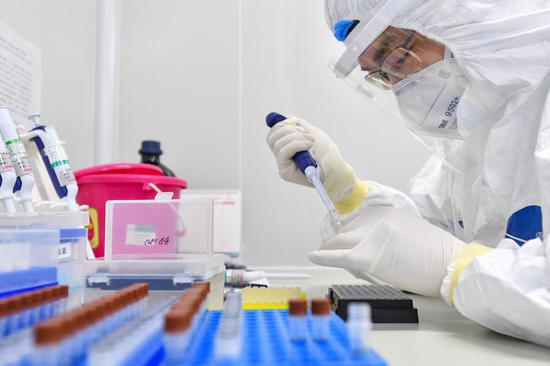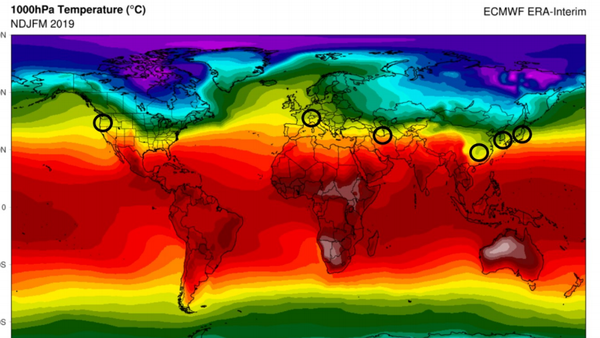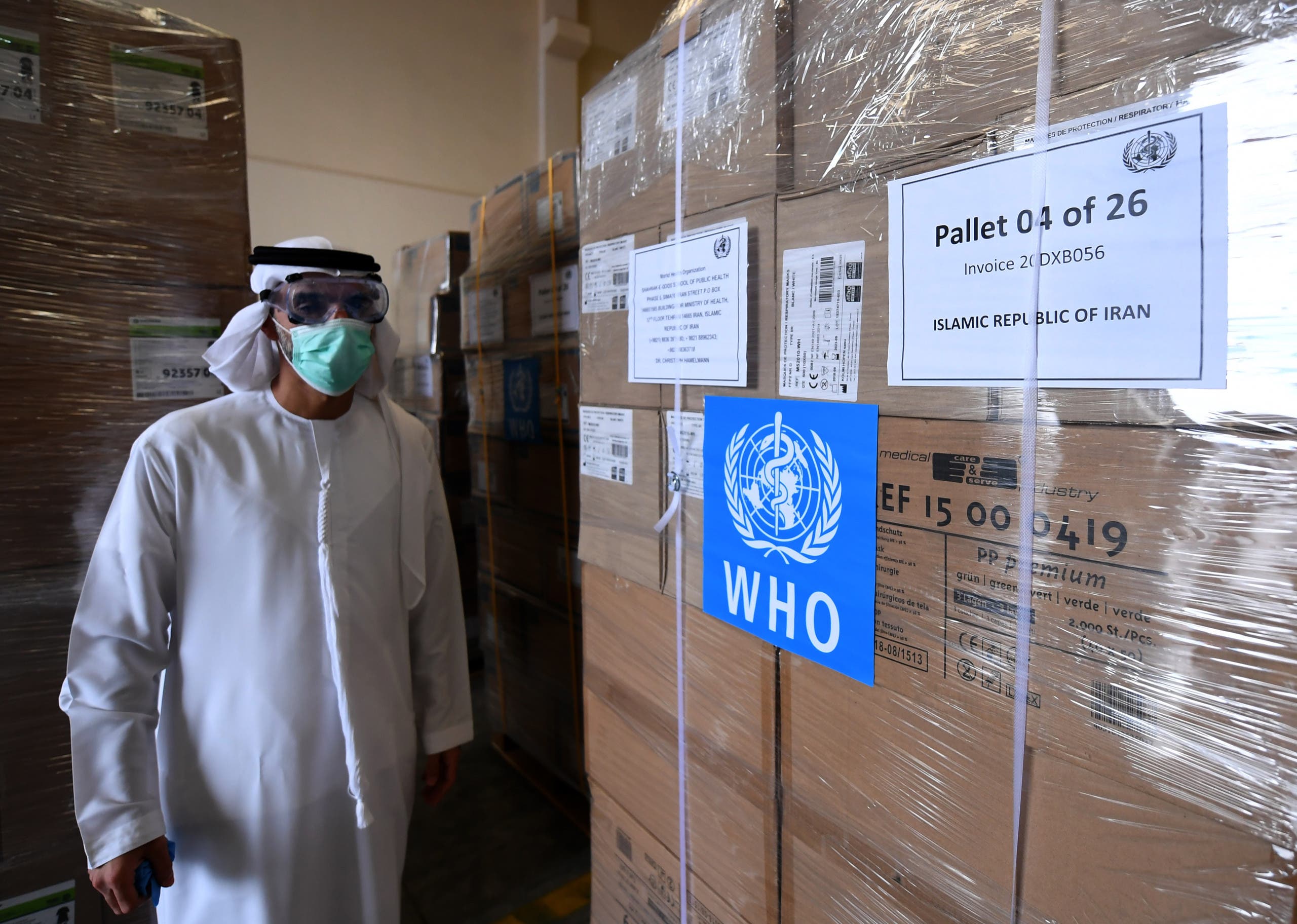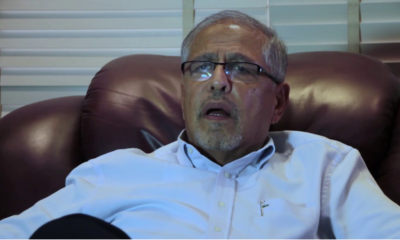As the world braces itself for a surge in coronavirus infections and governments put countries into lockdown to slow its wrath, one expert has issued a stark warning – coronavirus is here to stay.
Because COVID-19 is highly contagious and even those without symptoms can transmit the virus, social distancing and lockdown procedures are only a stop-gap measure and not a long-term solution.
“There’s no way to get rid of the virus at this stage. Then the question is how long it will stay with us – 10, 30, maybe 300 years. I don’t know. It could go away, but I’d find it very, very unlikely,” Francois Balloux, director of the University College London Genetics Institute, told Al Arabiya English.
Experts have various guesses as to how many could be killed in the UK and the US by coronavirus if mitigation is minimal.
An Imperial College report found even with non-pharmaceutical interventions – like suppression measures currently being taken – there could still be 250,000 deaths in Great Britain and 1.1-1.2 million in the US.
“Mitigation is unlikely to be feasible without emergency surge capacity limits of the UK and US healthcare systems being exceeded many times over,” the report read.
In the US, the CDC has predicted between 200,000 and 1.7 million Americans could die from COVID-19 if efforts to contain the virus are minimal, the New York Times reported.
Countries can’t afford to shut down indefinitely, as many have temporarily done to stem the spread. The economic recession caused by closing infrastructure can have significant public health repercussions, leaving authorities in a paradox where they must choose between short-term measures to control the virus’s spread or long-term economic and health concerns.
As coronavirus continues its sweep across the globe claiming lives and infecting thousands, experts warn the peak – when most people will contract COVID-19 – is yet to arrive in America and some European countries.
When that peak arrives depends on governments implementing precautionary measures – and populations following them strictly.
Without social distancing, or making an active effort to avoid large crowds, coronavirus would be due to peak in the West in two weeks, Balloux said. With measures in place, the peak could be delayed by up to two months, which gives governments more time to prepare.
But these measures are simply a way to ensure hospitals are not inundated within the next two months, Balloux said. Without a vaccine to protect the population “we just have to accept it’s here.”
Vaccines two years off
For a population to see a pandemic slow down, the majority need to develop protection against the virus – either by being vaccinated, or through “herd immunity,” where enough people become exposed to the virus that they are no longer susceptible to catching it again.
“Given that this is a new virus, everyone is susceptible since our bodies have not developed an immune response to it,” explained Dr. Kaveh Khoshnood, professor of epidemiology at Yale University’s School of Public Health.
“The outbreak will end when there are not enough susceptible people for this virus to infect,” he added.
However, Khoshnood said that it will likely be one to two years before a vaccine is available on the market.
Although lab testing is underway in the US, and the World Health Organization has said that more than 20 potential vaccines are in development, none are near completion.
This means that people will have to contract the virus naturally, rather than through a controlled vaccination process, and survive it if they are to develop immunity.
The UK government has considered the idea of letting this process happen with the aim of reaching herd immunity. However, there are significant risks attached to the strategy, and even at low mortality rates a significant part of the population can be expected to die.
Whether governments pursue containment or try to achieve herd immunity, more people are likely to die until a vaccine is developed and rolled out.
Winter is coming
Rather than being over by summer, as many hope, the coronavirus might be back in winter – more deadly than before.
One model suggests the virus could be the most damaging this winter in the northern hemisphere, infecting 100 times more people than now.
Balloux said he was most concerned about a coronavirus outbreak in winter as hospitals in areas with bad flu seasons are already under seasonal stress.
“Say we face something like we do face now, but in December, there will be carnage,” Balloux said.
He also warned that if coronavirus behaves like the 1918 influenza outbreak, which some models suggest, it could return not just in winter 2020 – but every winter from now on.
Potential effect of climate on coronavirus
Impossible to stop
Social distancing measures only work if borders remain shut, and in a globalized world, that’s not possible. Had the world simultaneously shut borders during the early days of the outbreak, it may have been more effective, said Balloux.
“Had they said ‘It’ll be costly, but let’s deal with that and get rid of that,’ that would’ve been good, but only two countries managed to keep it under control and it’s spreading everywhere,” Balloux said.
In China and South Korea, new daily case counts are lowering – signaling that these countries have passed the peak. But now, China has seen more than 60 imported cases of the virus, and Balloux said that a second round of community transmission could work its way through China.
“There’s no long-term plan,” Balloux said. “If everyone were completely isolated and no one had any contact, then obviously the virus would stop spreading. Now that’s not technically possible,” Balloux said.
More than 204,000 people have been infected with coronavirus and more than 8,700 have died as of Thursday.
“Economic death spiral”
Over the last two and a half months, the world has watched as the virus has wreaked havoc on economies and destroyed jobs. Markets have nosedived, with the US S&P 500 ending a historic 11-year bull run last week and entering a bear market.
Entire countries such as Italy have gone into lockdown, causing both short- and long-term economic consequences. In the US, nearly one in five American households have experienced a layoff or reduction in work because of the pandemic, according to a new NPR/PBS NewsHour/Marist poll.
And economic downturns have effects on long-term public health.
“Any hit to the economy means long-term loss of health and life expectancy,” Balloux said. “Look at places with high per-capita GDP, people live long healthy lives. If it’s low, people don’t live long healthy lives.”
But with the coronavirus outbreak, governments must now assess how they can limit the impact on the most vulnerable, who are often the first to lose their jobs.
Omar al-Ubaydli, researcher at Derasat, a think tank in Bahrain, told Al Arabiya English that coronavirus has not yet reached a stage where it’s likely to cause disruptions to international trade and global supply chain networks, but the massive social distancing efforts will cause distress for those without enough cash on hand to survive the crisis.
“Lay-offs will affect those people most,” al-Ubaydli said. “Social security is the most important thing right now.”
He said that now is not the time to worry about debt, and that countries must consider implementing large-scale social security programs – such as handing out cash. The US is currently considering such an option, and could begin sending checks to Americans as part of a $1 trillion stimulus package.
“Liquidity is the biggest issue, and ensuring money circulates is key to avoid an economic death spiral,” al-Ubaydli said.
Systems overstrained, stress high
Other experts have warned that the coronavirus could push key economic sectors into collapse – which will have an immense knock-on effect for society.
Societies tend to outgrow their resource base, Ugo Bardi, Professor in Physical Chemistry at the University of Florence (IT) and a theorist of societal collapse told Al Arabiya English.
“Once a society overshoots, the mechanism of returning is not linear. It has ups and downs,” he said.
Globally, the economic system is overstressed and overstrained because it overuses the resources it has, said Bardi.
“It takes just one shock to send the whole thing down,” he added.
Health systems not prepared
The strain on infrastructure is most evident in healthcare, with hospitals struggling to cope with the influx of patients in places reaching their peak infections. Experts have called to “flatten the curve” and slow down the number of new infections to give healthcare systems a chance to cope with the crisis.
In Italy, which has the highest death toll and death rate outside China, hospitals were poorly equipped for the outbreak. The country has an aging population, but hospitals don’t have enough ventilators, and there are simply not enough doctors, according to local media.
The Italian College of Anesthesia, Analgesia, Resuscitation, and Intensive Care published guidelines outlining criteria doctors and nurses should follow, forcing healthcare professionals to make moral choices about who lives, and who dies. The guidelines liken these modern moral choices to wartime triage.
They rule out a first-come, first-served policy; doctors should assess who is most likely to survive, based on criteria such as age and overall health, and allocate resources accordingly.
Modern medicine may have advanced, but crisis medicine isn’t much different than it was in 1918, Balloux said.
“The type of medicine we can give to patients when everything goes well, when there’s no stress, there’s no pressure, and everyone has an ICU bed and enough respirators [is different], but now the medics are essentially falling from exhaustion – I don’t think we should be complacent,” he said. “In terms of crisis, the health care we have hasn’t changed that much.”
It is not just Italy which is underprepared.
Yesterday, Tedros Adhanom, director-general of the WHO called for more testing to help break the trains of transmission. But globally, hospitals are under-prepared to ramp up testing. In the UAE, hospitals asked patients seeking testing to call ahead. In the US, the director of the National Institutes of Allergy and Infectious Diseases said last week there were not enough tests available for those who need them.
“There is a global shortage of supplies when it comes to laboratories and prevention and control,” World Health Organization Emergency Preparedness Manager Dr. Dalia Samhouri told Al Arabiya English.
Countries are now trying to ramp up their hospitals’ capacities and putting in emergency plans before the virus peaks. The ventilator industry is getting an onslaught of orders from Germany, Italy, and China. In the UK, the country’s health secretary called on manufacturers to build more ventilators. But lockdowns mean some companies are suspending operations, threatening future preparation.
“The other problem is that all this is more difficult with a sluggish economy. Where do you get the money from? Where do you train the doctors if the universities are closed?” Balloux said.
Life under lockdown
In countries that are still waiting for the peak, everyday life has changed drastically – and the new measures are likely to last months, according to health experts – perhaps causing long-term changes in human behavior.
Governments are enacting more severe social distancing measures, with some countries halting all flights, companies enacting work-from-home policies, bars and restaurants issuing new guidelines on how to serve food, and some individuals taking greater measures to avoid contact with those around them.
But in some countries, like the US, some are yet to fully comprehend the gravity of the situation.
In New Orleans, police cleared out the popular bar district, Bourbon Street, and can be heard over speakers saying “Your actions are jeopardizing public health.” In Spain, drones now monitor the streets.
For many, this new reality is unprecedented. Humans in 2020 are unaccustomed to having to take such draconian measures to protect themselves from an invisible enemy.
“This is a change because we’re not used to this way of life in this century. There are major and sudden changes, and people did not have the time to adapt to it properly,” Mario Aoun, Clinical Psychologist, Healthpoint, a UAE healthcare provider, told Al Arabiya English.
Now, coping with the psychological impact of the lockdown orders and social distancing is the next challenge. Experts have already warned of the toll social isolation may take on individuals’ mental health.
“This might create some kind of trauma for vulnerable individuals, not for everyone, but for certain people who are predisposed or those who are already anxious,” Aoun said. “In certain cases, it might be hard to get over.”
However, Aoun said that human beings have great capabilities to adapt and manage.
“We see chaos, that’s also true, but human beings have proven so far that they are of great faith and they’ll manage to get over it,” he said.
Source.
Kenya Insights allows guest blogging, if you want to be published on Kenya’s most authoritative and accurate blog, have an expose, news TIPS, story angles, human interest stories, drop us an email on [email protected] or via Telegram

 A screenshot from the University of Maryland study shows coronavirus hotspots along the same climate band. (Screengrab)
A screenshot from the University of Maryland study shows coronavirus hotspots along the same climate band. (Screengrab)
 Tons of medical equipment and coronavirus testing kits provided by the World Health Organization are pictured at the al-Maktum International airport in Dubai on March 2, 2020 as it is prepared to be delivered to Iran. (AFP)
Tons of medical equipment and coronavirus testing kits provided by the World Health Organization are pictured at the al-Maktum International airport in Dubai on March 2, 2020 as it is prepared to be delivered to Iran. (AFP)
















